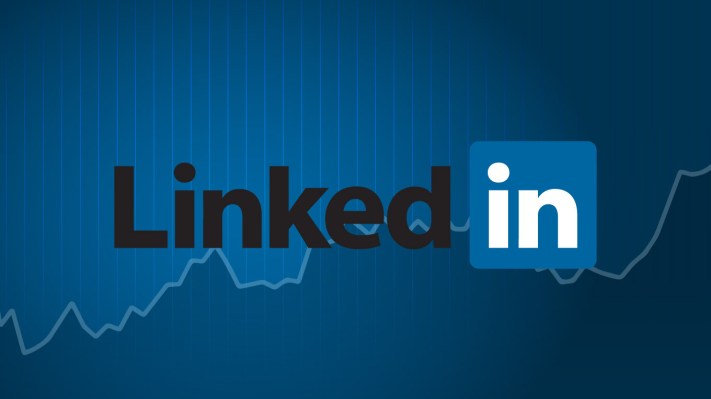With social networks Facebook and Twitter handily beating analyst estimates for Q2 earnings, LinkedIn today reported its Q2 results and showed that rising tides are lifting its boat, too. Revenue for the second quarter was $534 million and its EPS (non-GAAP diluted) was $0.51 as the company also raised its guidance for Q3 and the full year. The company’s stock is up by around 8% in after-hours trading to $195 a share.
Analysts expected LinkedIn to post earnings per share (EPS) of $0.39 (non-GAAP diluted) on revenues of $511 million. As a point of comparison, last quarter, LinkedIn beat analysts’ estimates on sales of $473 million and EPS of $0.38. Today’s revenue numbers are up 47% on a year ago, when LinkedIn posted revenue of $364 million in Q2 2013.
“LinkedIn delivered strong financial results in the second quarter while maintaining investment in our member and customer offerings,” said Jeff Weiner, CEO of LinkedIn, in a statement. “We made significant progress against several key strategic priorities including increasing the scale of job opportunities on LinkedIn; expanding our professional publishing platform; and continuing the strategic shift towards content marketing through Sponsored Updates.”
LinkedIn, however, also posted a GAAP net loss for the quarter of $1.0 million, versus net income of $3.7 million a year ago. Non-GAAP, the net income was $63 million, versus $44 million in Q2 2013.
On the back of its generally strong results, LinkedIn also raised its revenue guidance for the quarter ahead and the full year, above the estimates from analysts. It says it expects to Q3 revenues of $543-547 million, versus First Call and FactSet revenue estimates of $541m. For the full year, it bumped up numbers by $75 million to $2.140-2.150 billion; First Call and FactSet both estimate $2.12 billion.
LinkedIn, a social network built around people’s professional/working connections, passed the 300 million registered user mark in Q1. But while LinkedIn has evolved into the most ubiquitous of the “professional” social networking platforms in places like the U.S. and Europe, many have wondered how the company’s growth will fare in the future. (Indeed, LinkedIn’s stock has been punished in quarters past because of the slowing revenue growth, even when LinkedIn has actually beaten estimates. At market close today, it was at around $180 per share, down significantly from a 52-week high of nearly $258/share.)
LinkedIn’s growth question is focused on a few key areas: in terms of picking up new users beyond the white-collar workers who are its current bread and butter; moving into new geographies; and maximising revenues on users that the company already has.
In the last quarter, LinkedIn made some key moves to bolster the third of these areas, building revenue potential from its current user base. They included the acquisition of Bizo for $175 million. Bizo provides targeting and analytics for business — technology that LinkedIn intends to integrate with its current products to, in LinkedIn’s own words, breat a “more powerful tool for brands that want to build stronger relationships with professionals.”
In other words, this will help build out LinkedIn’s advertising and marketing business — one area that people will be scrutinizing when they compare LinkedIn with other publicly-listed social networks like Facebook and Twitter, who are pushing hard on their ad sales, specifically in the area of mobile.
Mobile, overall, is another area where LinkedIn has been working hard to build a bigger audience. It already has a large audience accessing the site from mobile devices — 45% of traffic from its 313 million users comes from mobile, Weiner noted today — so this is about trying to capitalize on that.
In addition to relaunching its main mobile app, it’s also been looking at ways of expanding its audience through different apps and services — for example through its Connected app, a relaunch of its Contacts app that hints at how the company wants to build leverage new technology and concepts like anticipatory computing and AI to make interacting and using LinkedIn less taxing and more seamless. (More use, after all, translates to more data and more revenue opportunities for social networks.)
This quarter, LinkedIn shifted around its accounting a bit and put its recruitment media products into talent solutions from their previous home of marketing solutions — which essentially makes sense since now it’s in the same category as LinkedIn’s other job-related businesses. Revenues for both of these categories, along with premium subscriptions, all rose by over 40% over last year, with talent solutions reaping the biggest growth (49%) and biggest sales of all at $322 million, keeping its position at an even 60% of revenues compared to last year.
Marketing solutions and premium subscriptions were roughly equal in their revenue contribution at $106 million and $105 million, respectively, both up 44% and each accounting for 20% of overall sales. We’ll listen in to the conference call in a bit to see whether LinkedIn or analysts have anything to say on this front. One thing I would point out is that although LinkedIn is trying to position itself as a community platform and a place to visit more than when you are looking for a job (or to hire someone), it seems like this remains at the heart of its business. (And to be clear it is not one that it is ignoring — witness the company’s acquisition of Bright to boost its job listings.)
In its non-recruitment business, another data point reported today: LinkedIn is now seeing 30,000 weekly long-form posts “after ramping posting capability to 15 million LinkedIn members,” the company writes. “Since launching in February, traffic to publisher and Influencer posts has risen more than 100%.”
